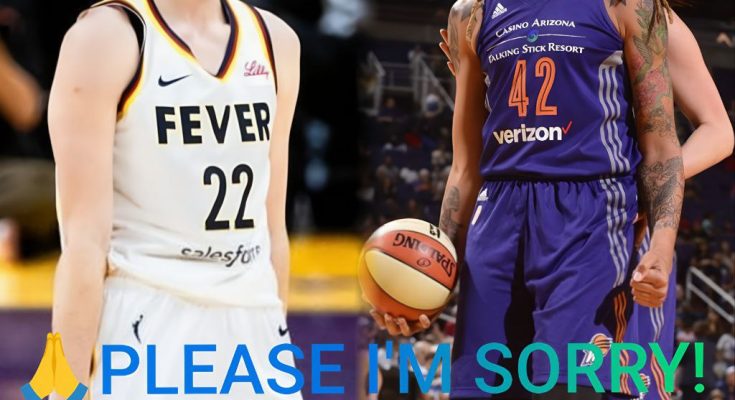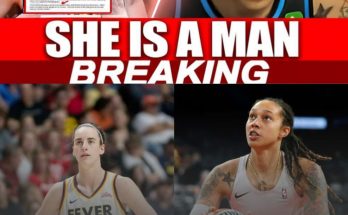>The WNBA, a league that has fought for decades to be taken seriously in the world of professional sports, now finds itself at a crossroads—one defined not by buzzer-beaters or championship banners, but by a controversy that threatens to unravel the very fabric of its integrity. At the heart of this firestorm is an incident involving two of the league’s most recognizable names: Brittney Griner, the towering center now with the Atlanta Dream, and Caitlin Clark, the rookie sensation whose arrival has electrified women’s basketball.<

It all began on a seemingly ordinary Thursday night as the Indiana Fever clashed with the Atlanta Dream. For Griner, the night was anything but ordinary; plagued by foul trouble and stifled by Clark’s relentless energy, she managed just five points in 25 minutes before fouling out late in the fourth quarter. But what happened as Griner made her way off the court would send shockwaves through the league.
Cameras captured Griner, visibly frustrated, appearing to mouth the words “effing white girl” in Clark’s direction. The footage, quickly dissected by fans and analysts alike, spread like wildfire across social media. While lip-reading is an imperfect science, the consensus among viewers was clear: Griner had crossed a line, uttering language that would be deemed unacceptable in any professional environment.
The outrage was immediate and widespread. Imagine, critics argued, if the roles were reversed—if Clark had been caught on camera using a racial slur against a Black player. The internet would have erupted, sponsors would have fled, and the league would have been forced to respond with swift and decisive action. Instead, as the video circulated and the debate intensified, the WNBA’s response was deafening silence.
-A League at a Crossroads
This incident did not occur in isolation. For months, Clark has been the target of physical and verbal harassment on the court, a pattern that has become impossible to ignore. Her meteoric rise—breaking attendance records, shattering jersey sales, and drawing unprecedented media coverage—has not only revitalized the league but also exposed deep-seated tensions among players.
Some see Clark’s success as a threat to the established order, a challenge to the dominance of veteran stars who have long carried the league on their shoulders. Others, more cynically, suggest that her race plays a role in the hostility she faces. The uncomfortable truth is that Clark, a white woman in a league where the majority of players are Black, represents a shift in the WNBA’s cultural landscape—one that not everyone is ready to embrace.
The Griner incident, then, is more than a moment of poor sportsmanship. It is a flashpoint in a broader conversation about race, respect, and the responsibilities of professional athletes. When Griner, a veteran and former league MVP, resorts to language that would be grounds for termination in any other workplace, it raises serious questions about the standards to which WNBA players are held.
-Selective Enforcement and a Culture of Silence
Perhaps the most damning aspect of this controversy is the league’s response—or lack thereof. While the WNBA has been quick to hand out fines and technical fouls for minor altercations, its silence on Griner’s apparent use of racial language speaks volumes. In the same game, Clark and Atlanta’s Rhyne Howard were both assessed $30 fines for a heated exchange, as if both were equally responsible for whatever transpired. Yet when it comes to Griner’s outburst, there has been no official statement, no investigation, no consequences.
This selective enforcement has become a hallmark of the WNBA’s disciplinary process. When Clark is involved in an altercation, the league is quick to assign equal blame, regardless of the circumstances. But when she is the target of behavior that crosses ethical and professional boundaries, the league turns a blind eye.
The message this sends is clear: Certain players are above reproach, while others—no matter how much they contribute to the league’s success—are left to fend for themselves. It is a double standard that undermines the credibility of the WNBA and alienates the very fans Clark has brought to the sport.
-The Business of Basketball
From a business perspective, the league’s failure to protect Clark is nothing short of self-sabotage. Her impact on television ratings, merchandise sales, and sponsorship deals is measurable and unprecedented. She has transformed Tuesday night games into must-see events and brought a new generation of fans to women’s basketball.
Yet instead of celebrating and safeguarding its most valuable asset, the WNBA seems content to allow Clark to become a lightning rod for resentment and hostility. The league’s reluctance to take a stand against inappropriate behavior not only puts its star player at risk but also threatens the long-term health of the sport.
Sponsors, broadcasters, and fans want to invest in a league that upholds professional standards and protects its athletes. If the WNBA cannot demonstrate that it is capable of addressing toxic behavior—regardless of the perpetrator—it risks losing the momentum Clark has generated.
-A Call for Leadership
The Griner-Clark incident is a test of the WNBA’s leadership. Will Commissioner Cathy Engelbert and the league’s executives have the courage to enforce their own code of conduct, even when it means holding star players accountable? Or will they continue to prioritize avoiding controversy over maintaining the integrity of their sport?
A meaningful suspension for Griner would send a powerful message: that racial language has no place in professional basketball, and that all players—regardless of status, race, or popularity—are subject to the same standards. It would show Clark, her teammates, and the next generation of athletes that the league takes workplace harassment seriously and is committed to protecting its players.
Failing to act, on the other hand, would confirm the worst suspicions of fans and critics alike: that the WNBA is unwilling to confront uncomfortable truths, even at the expense of its own credibility.
-The Future of the League
As the debate rages on, one thing is clear: The WNBA stands at a pivotal moment in its history. The decisions made in the wake of this controversy will shape not only the league’s public image but also the experience of every player who steps onto the court.
If the WNBA hopes to build on the momentum Clark has created, it must demonstrate that it is willing to protect its stars and uphold the values of respect, equality, and professionalism. Anything less is a disservice—to the players, to the fans, and to the future of women’s basketball.



